The idyllic comedy Peleskei Nótárius ('The Notary of Peleske') premièred at the Pest Hungarian Theatre on 8 October 1838. Following its success, folk plays became a popular genre in Hungary as well. The Hungarian folk play is an entertaining genre of theatre that draws inspiration from Hungarian folk tales, music and dance. The extremely popular genre also reflected on the socio-political events of its age. Songs written by popular composers increased the popularity of certain performances.
After the Austro–Hungarian Compromise of 1967 works increasingly turned to rural themes and idealised village. Eventually, fans of the genre ensured that it was given its own theatre. The Népszínház opened on 15 October 1875.
Proponents of the movement founded a company and issues shares in an attempt to raise the necessary capital with limited success. The local government of Pest took up the cause in 1871, and a committee was formed to oversee the project, led by Béla Lipthay. The construction of the outer ring road gave the initiative a huge boost, as the city donated a plot for the theatre, so "that the Capital has a popular theatre to ensure Magyarisation and the spread of the National spirit of the time, and support the development of Hungarian theatre that meets and nurtures Good taste." (Source: Supplement of the Budapest Official Gazette, 21 April 1872)
The Public Works Committee found that Hermina Square would be the best location for the building. The exact location changed several times through 1873, but eventually, the plot between Kerepesi Road and Sertéskereskedő (present-day Népszínház) Road was chosen. At the time the area was on the outskirts of the city, but due to the development of the outer ring road and urbanisation, it became a major transportation junction by the turn of the century.
Construction began in 1874, with plans made by the Austrian Fellner and Helmer Company. Several theatres in Hungary were constructed following plans by Ferdinand Fellner and Herman Helmer: Szeged, Fiume (present-day, Rijeka, Croatia), Pozsony (now Bratislava, Slovakia), Tata, Kecskemét), the Budapest Orpheum (1894) and Vígszínház (1896).
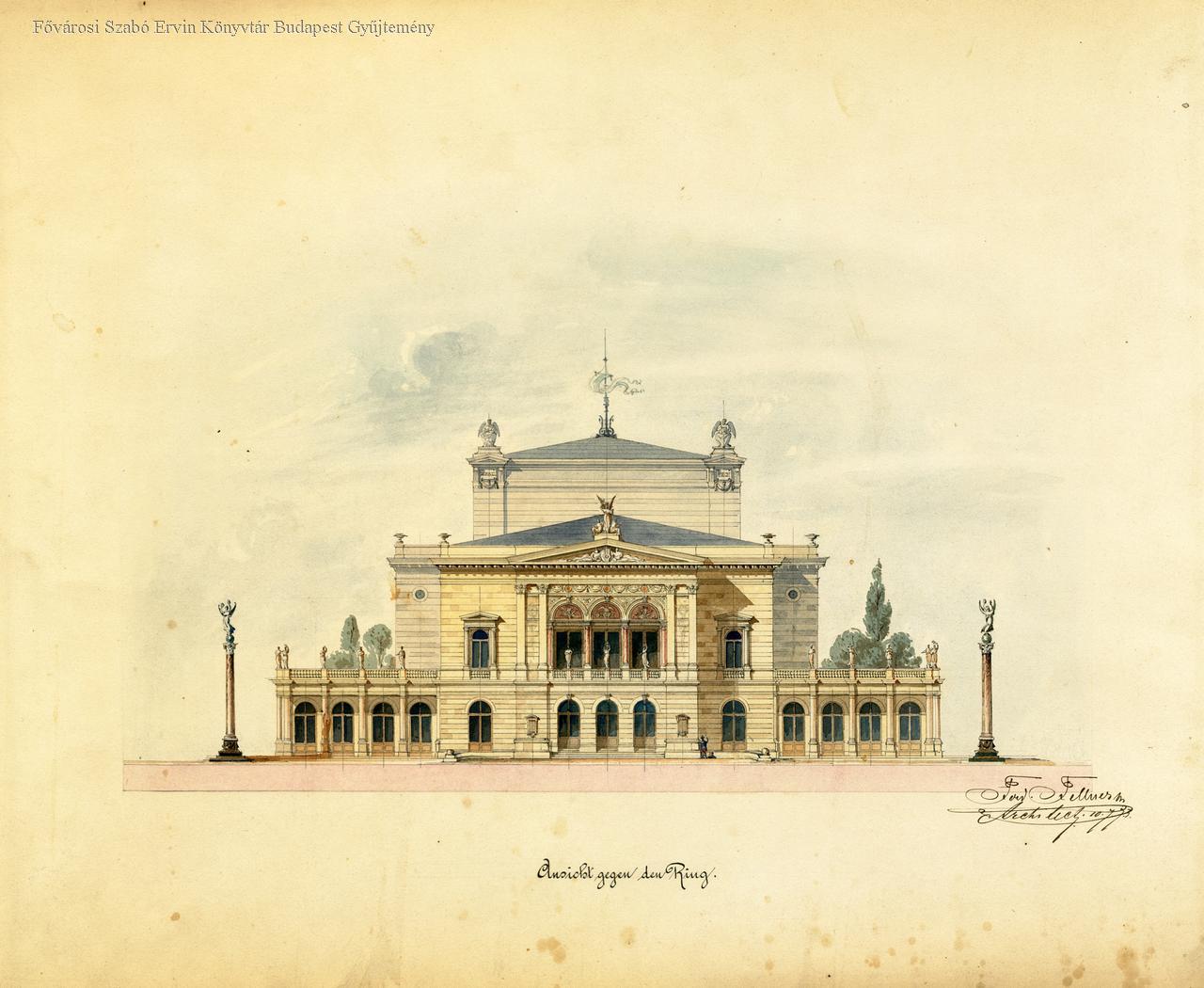 Ferdinand Fellner's and Herman Helmer's 1872 plan for the main façade (Photo: FSZEK Budapest Collection)
Ferdinand Fellner's and Herman Helmer's 1872 plan for the main façade (Photo: FSZEK Budapest Collection)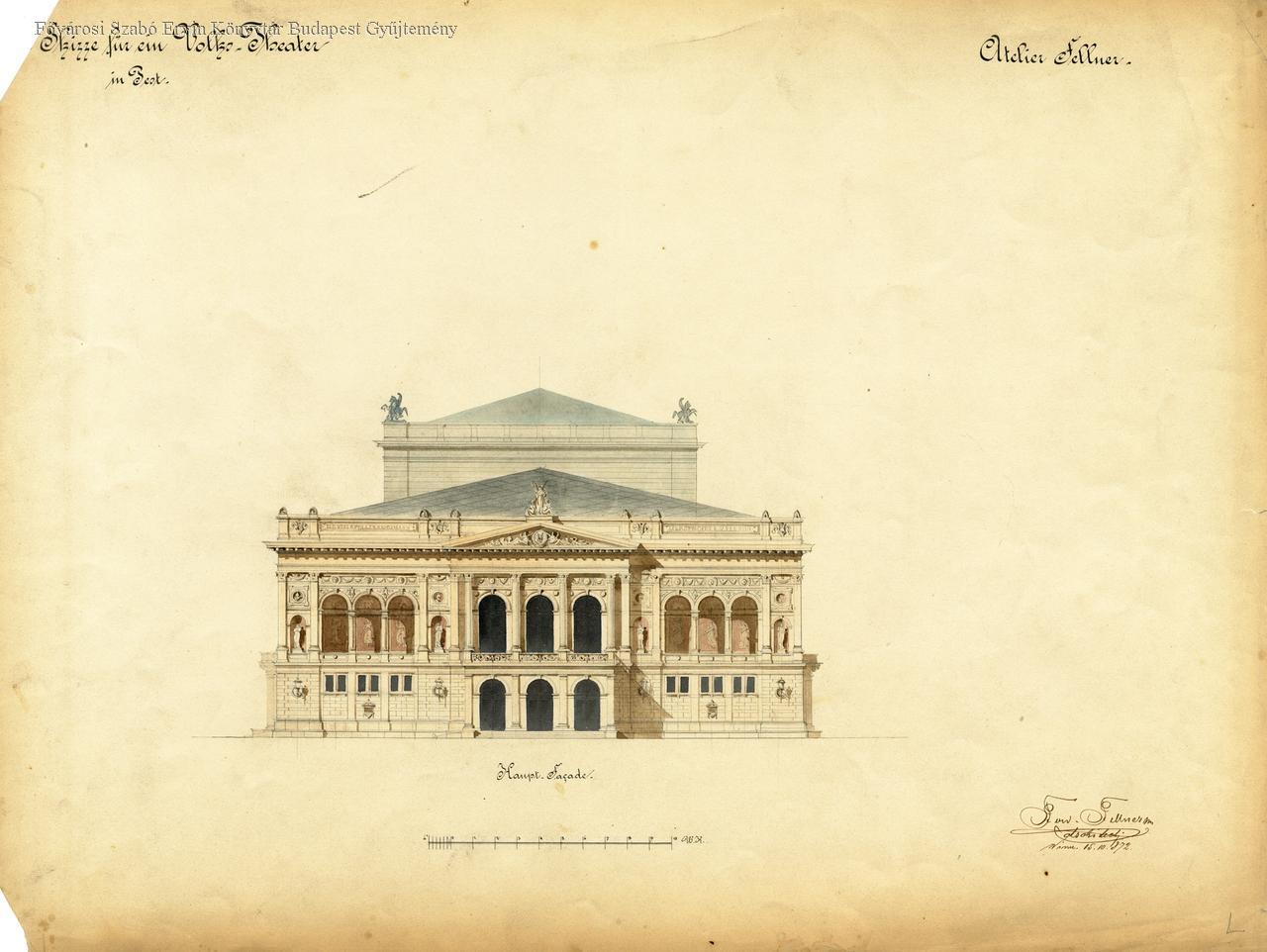 Ferdinand Fellner's and Herman Helmer's 1872 plan for the back façade (Photo: FSZEK Budapest Collection)
Ferdinand Fellner's and Herman Helmer's 1872 plan for the back façade (Photo: FSZEK Budapest Collection)
Contemporary newspapers reported on every detail of the new theatre's creation, from the idea, through the planning and construction to the grand opening. Construction was led by the builders Bódog Buzzi and Nalóleon Kéler. The stage and internal machinery were designed based on Viennese and Parisian examples. Jakab Kauser and Neusohler handled the stone carving.
In the end, the theatre was built bot with a facade facing the new Boulevard but reversed, facing the city centre. Six Corinthian columns decorated the facade, and statues of József Gaál, Károly Kisfaludy and Béni Egressy were played in alcoves between them. The roof was adorned with mythological figures, with Apollo at its peak.
The auditorium was dominated by white and light beige. Boxes and seats were covered in red, the walls decorated with frescos. Fifty boxes alongside the royal box were available for distinguished guests, while the theatre's total capacity neared 2000.
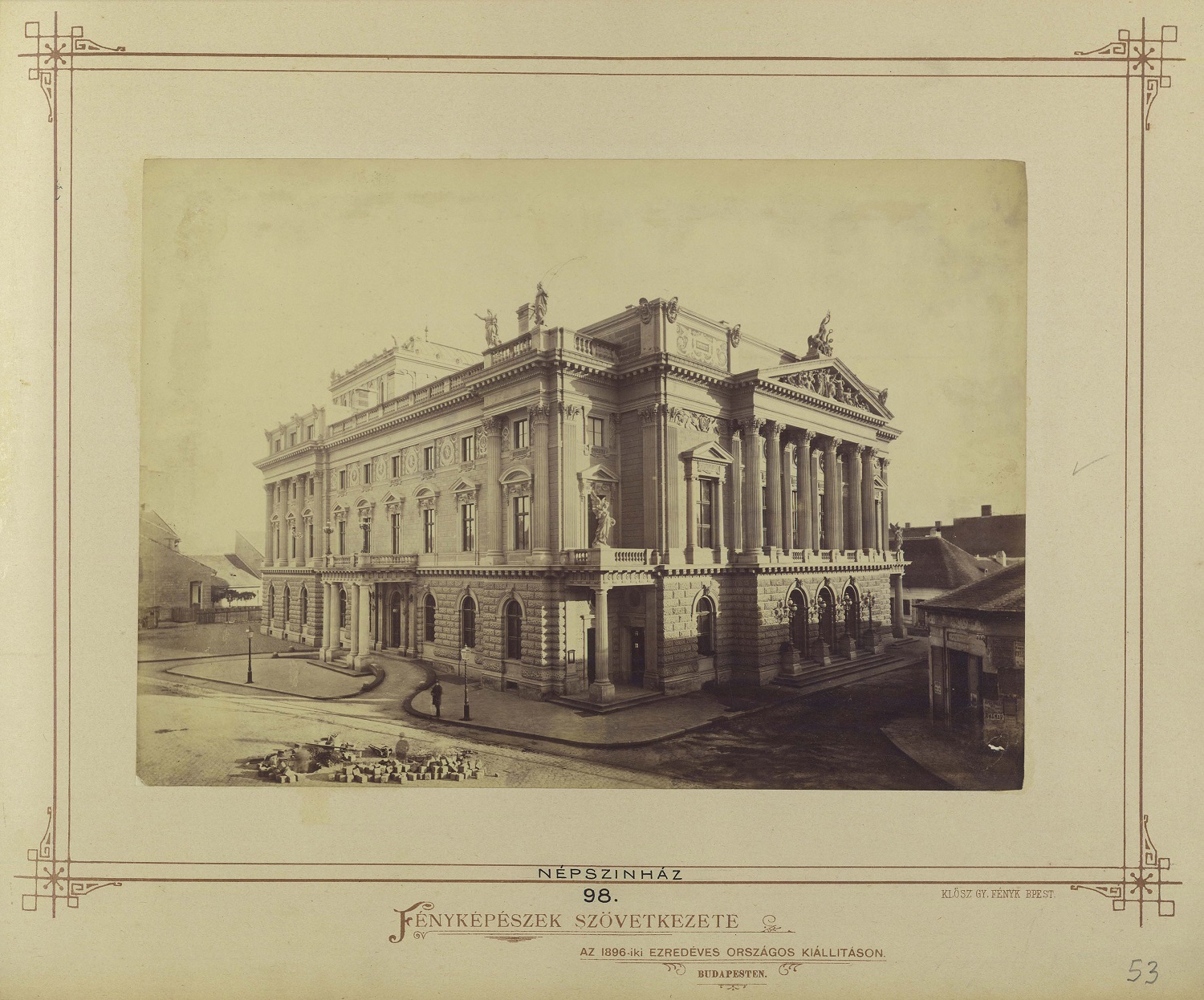 Népszínház photographed by György Klösz around 1875. The picture clearly shows that small two-storey buildings surrounded the theatre at the time, the eclectic residential buildings, so characteristic of the outer ring road today had not yet been built (Photo: Fortepan/Budapest Archives/Photographs by György Klösz)
Népszínház photographed by György Klösz around 1875. The picture clearly shows that small two-storey buildings surrounded the theatre at the time, the eclectic residential buildings, so characteristic of the outer ring road today had not yet been built (Photo: Fortepan/Budapest Archives/Photographs by György Klösz)
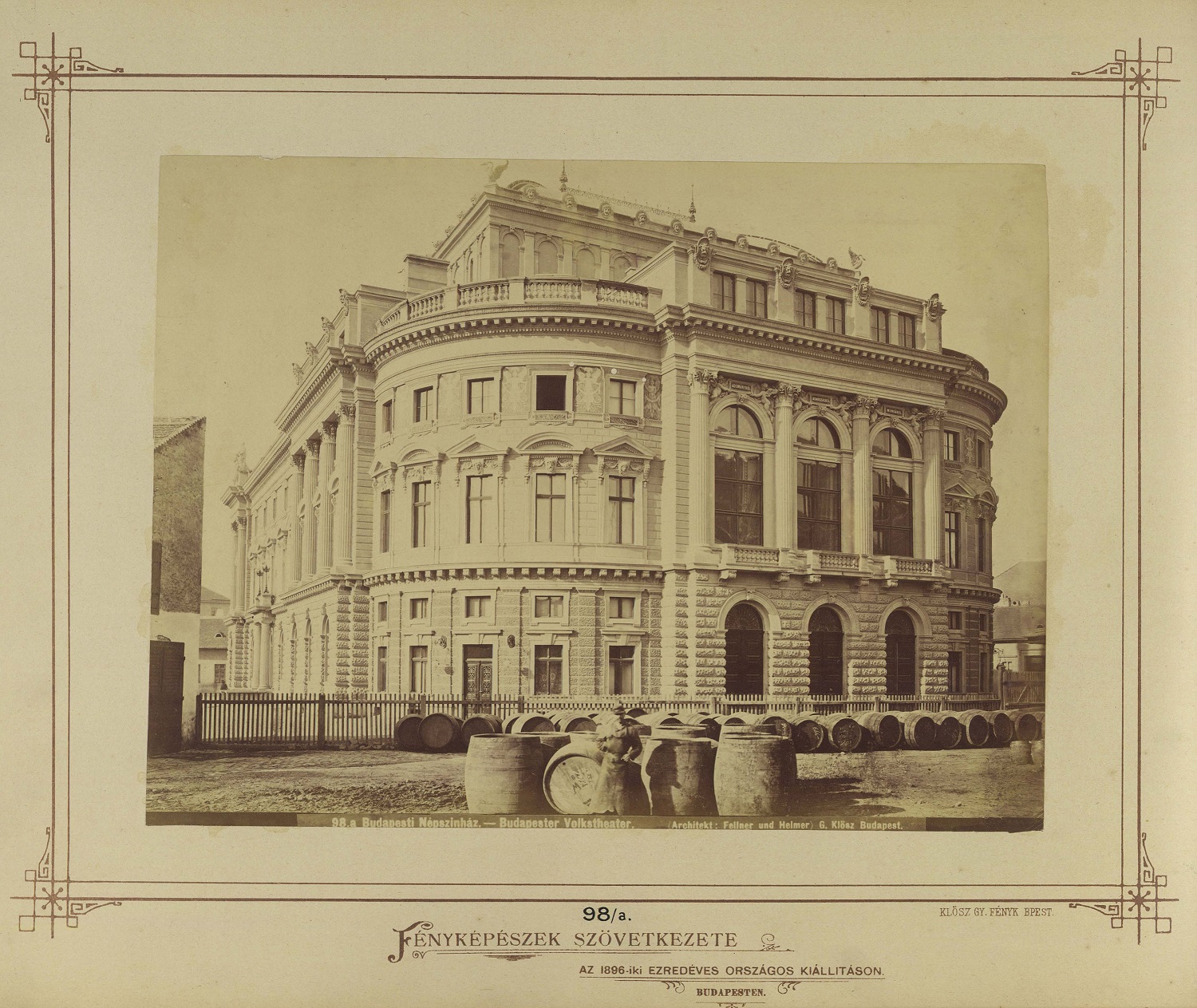 The back facade of Népszínház facing the Boulevard photographed by György Klöszaround 1875 (Photo: Fortepan/Budapest Archives/Photographs by György Klösz)
The back facade of Népszínház facing the Boulevard photographed by György Klöszaround 1875 (Photo: Fortepan/Budapest Archives/Photographs by György Klösz)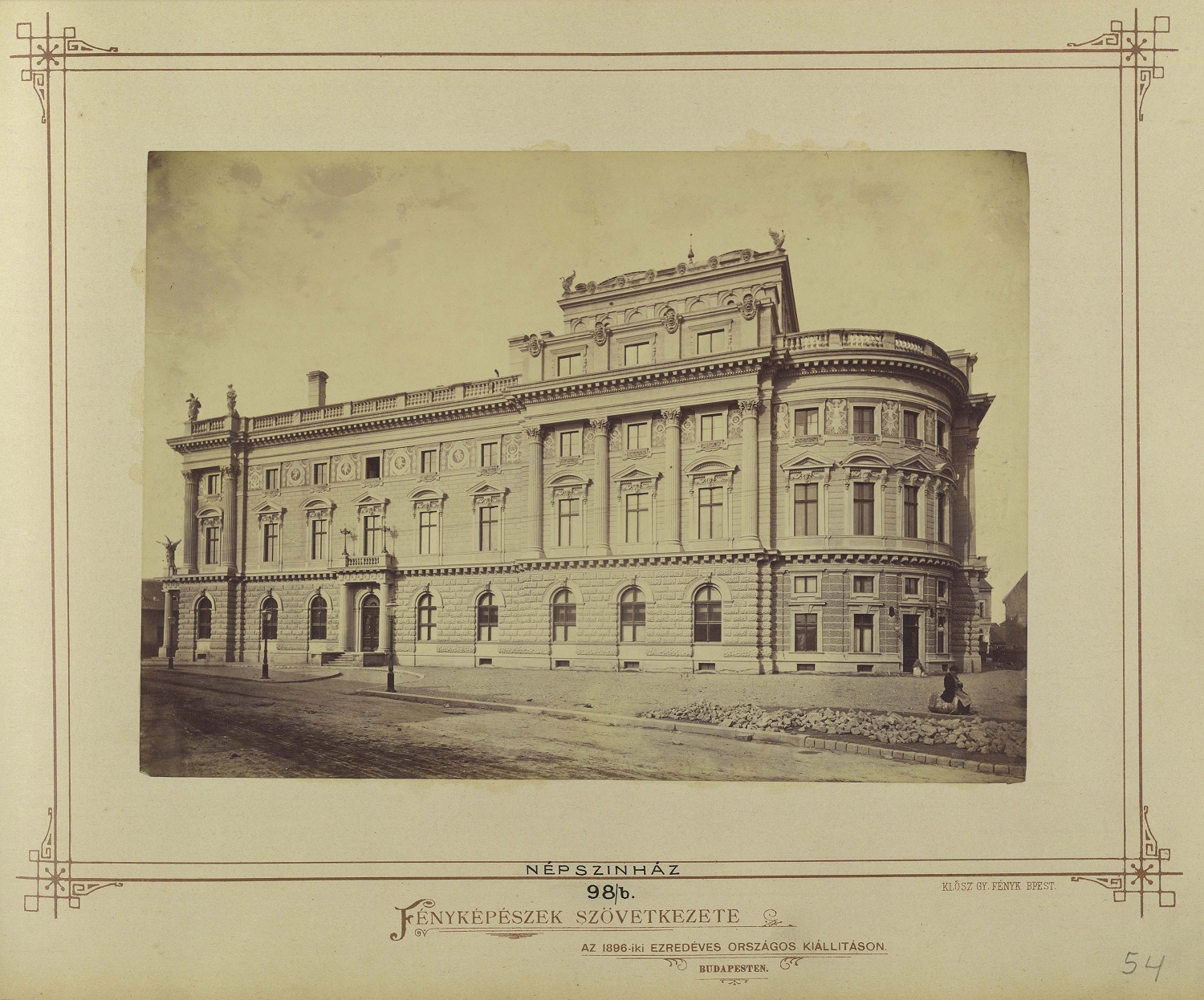
Side view of Népszínház (Photo: Fortepan/Budapest Archives/Photographs by György Klösz)
The most detailed description of the new building was published in the 24 October 1875 issue of Magyarország és a Nagyvilág:
"Changing the orientation of the building resulted in other changes. Pavilion-like protrusions would have decorated the façade toward the Boulevard to fill the wider space available there. These were not built, and flower gardens have been created to fill the space. (...) The auditorium is governed by the deep sour-cherry red rows of seating, and the similar colour of the boxes and deep red silk curtains. The walls are of a golden-white. The dividers between boxes are decorated with arabesque patterns and small cupid figures. Grinning satyrs decorate column heads. Eight allegorical groups decorate the roof. (...) A massive pear-shaped chandelier made of glass prisms provides light with gas burning in the centre. (...) The stage itself is a different world. The stage and its side rooms almost take up as much space as the auditorium. Two underground levels run below the stage, while above it a suspended maze of bridges beams and ropes crisscross each other."
The first director of the theatre was Jenő Rákosy, who leased it for three years. Rákosy took an active role not only in the initial first planning of the theatre and the first collection of funds but also in preparatory work, as the clerk of the construction committee. He also signed an agreement with the National Theatre under which the Popular Theatre would perform folk plays and musical works, and the National Theatre played tragedies and higher comedies.
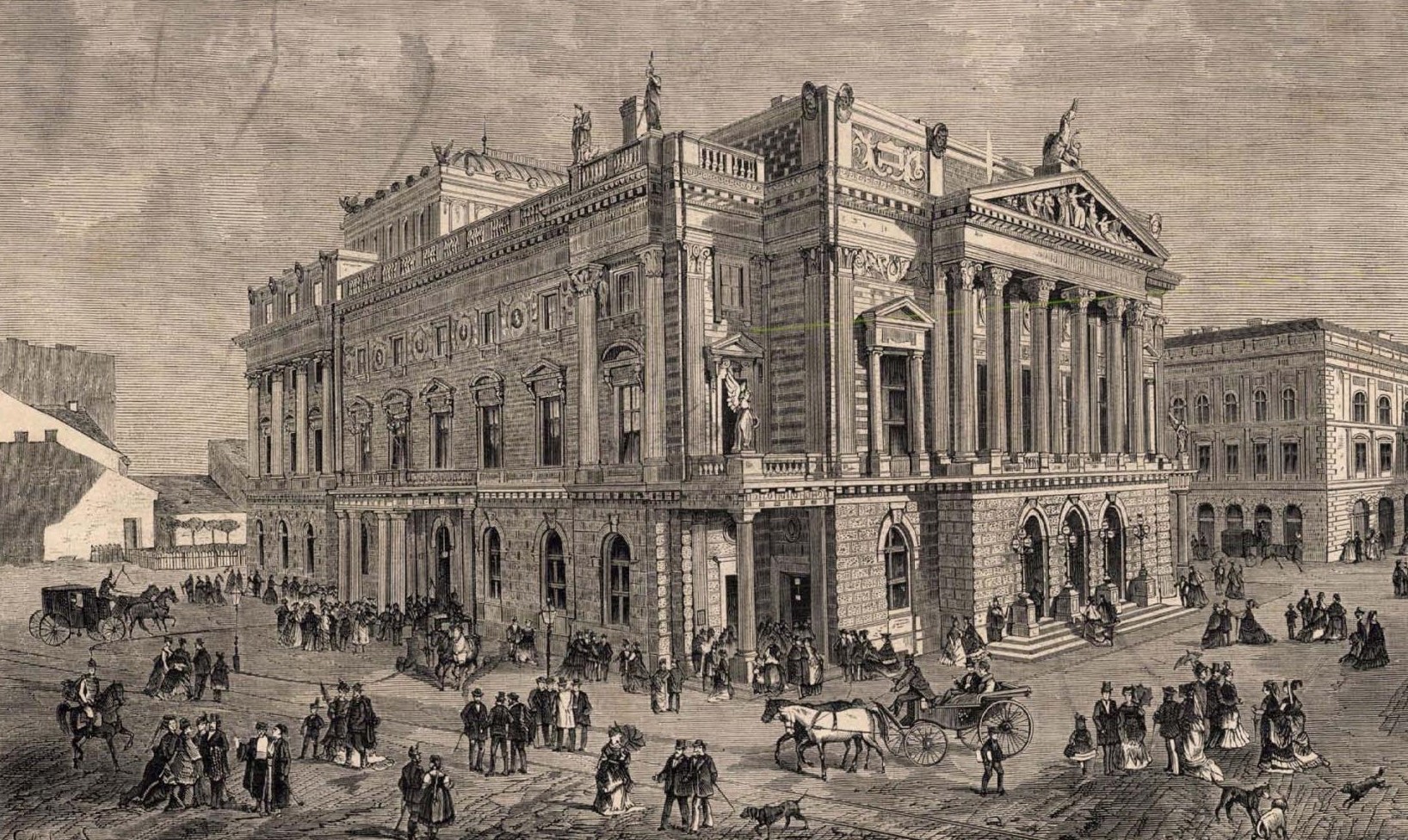 A graphic of Népszínház published in the 19 December 1875 issue of Vasárnapi Újság based on the photograph by György Klösz
A graphic of Népszínház published in the 19 December 1875 issue of Vasárnapi Újság based on the photograph by György Klösz
The grand opening took place on 15 October 1875 and was attended by Franz Joseph. The Hungarian political elite was also present: Prime Minister Béla Wenckheim, Kálmán Tisza and Kálmán Széll attended. The opening performance consisted of three acts. The first was the allegorical scene entitled Fölavatás ('inauguration'), which depicted the relationship between the National Theatre and the Popular Theatre, and the one-act folk play entitled Leánykérő ('The proposal'). The farce Jeremiás siralmai ('Jeremiah's lamentations') was the second act, and the third was the operetta A király csókja ('the king's kiss'). The event was closed with the Spear Dance. While the opening shows were not received extremely well by critics or the audience, the venue soon became hugely popular in Budapest.
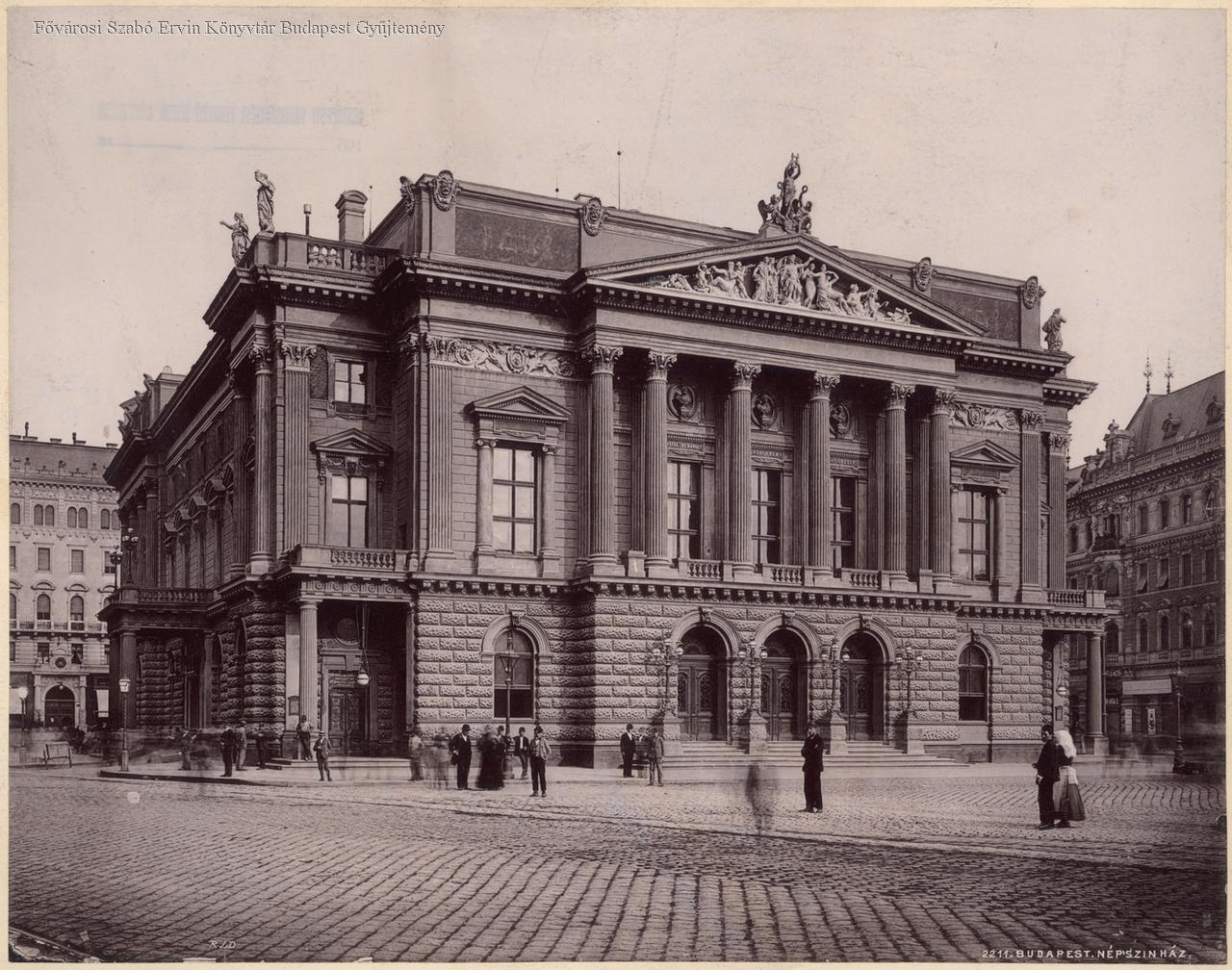 The building of the National Theatre around the turn of the century (Photo: FSZEK Budapest Collection)
The building of the National Theatre around the turn of the century (Photo: FSZEK Budapest Collection)
The opening troop was filled with well-known names: Fanny Rákosi, Emilia Sziklai, Nina Dancz, Zoltán Zádor, Elek Solymosi, Bandi Szabó, Miklós Tihanyi, Gusztáv Eőry Pordán. Lujza Blaha, first performed at the Popular Theater on 22 October 1875, in a new folk play, Kálmán Tóth's Ördög párnája ('devil's pillow'). The theatre's conductor was Erkel Elek.
On the occasion of the opening of the Budapest Popular Theater, the king donated to it four thousand forints and honoured its builders, awarding architect Ferdinand Fellner, the builder Napoleon Kéler and carpenter Guegbrand Gregersen the Knight's Cross of the Order of Franz Joseph.
The surroundings of the theatre also changed in the following years. The small two-storey houses of the area were destroyed and replaced with 3–4-storey eclectic residential palaces.
The façade of the theatre looked towards the city centre and its back towards the Boulevard of the outer ring road. Sertéskereskedő Street was renamed Népszínház Street and widened. A square formed around the building, which has been known as Blaha Lujza Square since 1920.
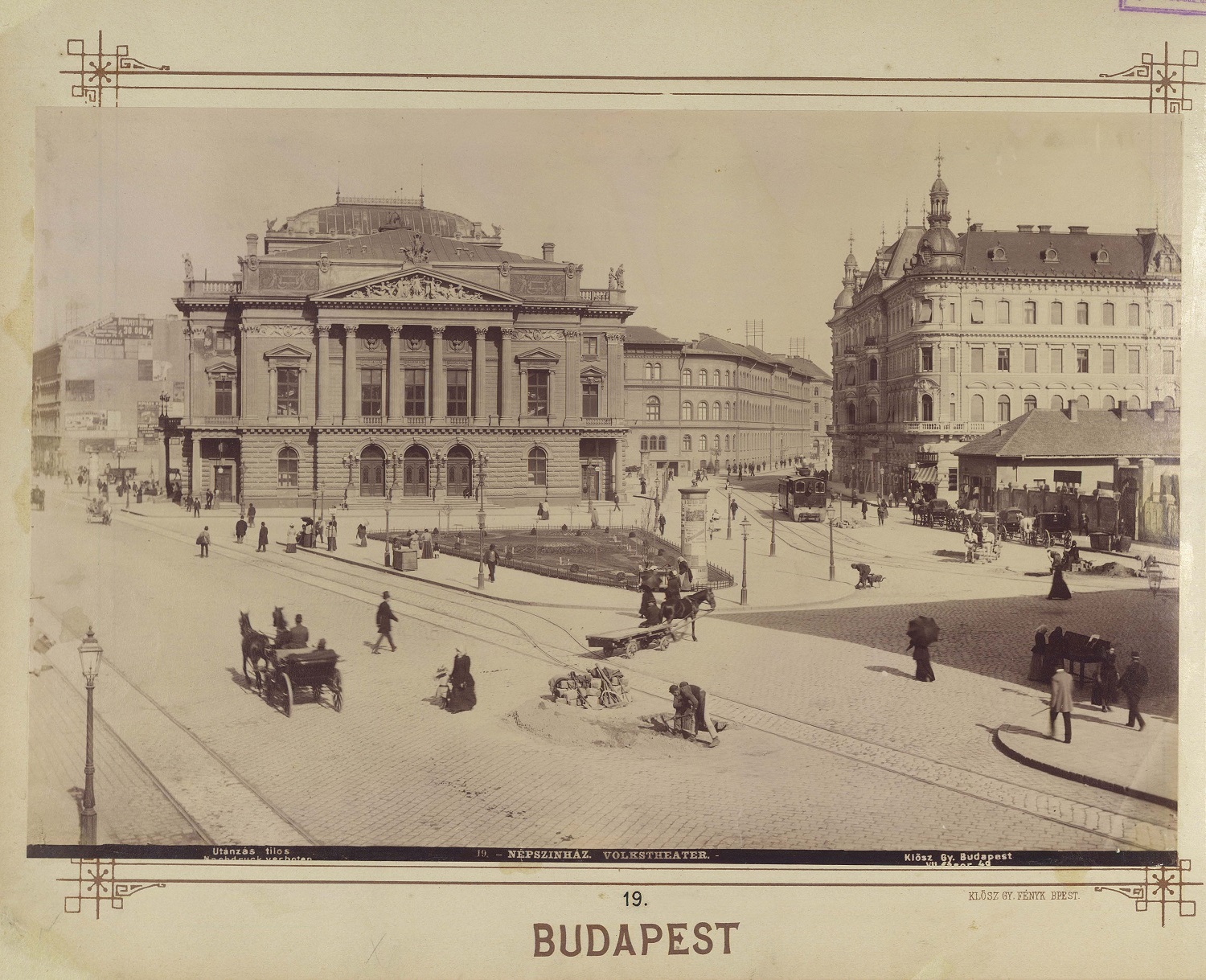 Népszínház and its surroundings in 1893, the present-day Blaha Lujza Square (Photo: Fortepan/Budapest Archive/Photographs by György Klösz)
Népszínház and its surroundings in 1893, the present-day Blaha Lujza Square (Photo: Fortepan/Budapest Archive/Photographs by György Klösz)
The Popular Theatre operated in this form until the summer of 1908. The popularity of theatre at the turn of the century and a series of new theatres opening resulted in difficulties for the institution. The National Theatre leased the building between 1 July 1908 and 1948, which then became its property.
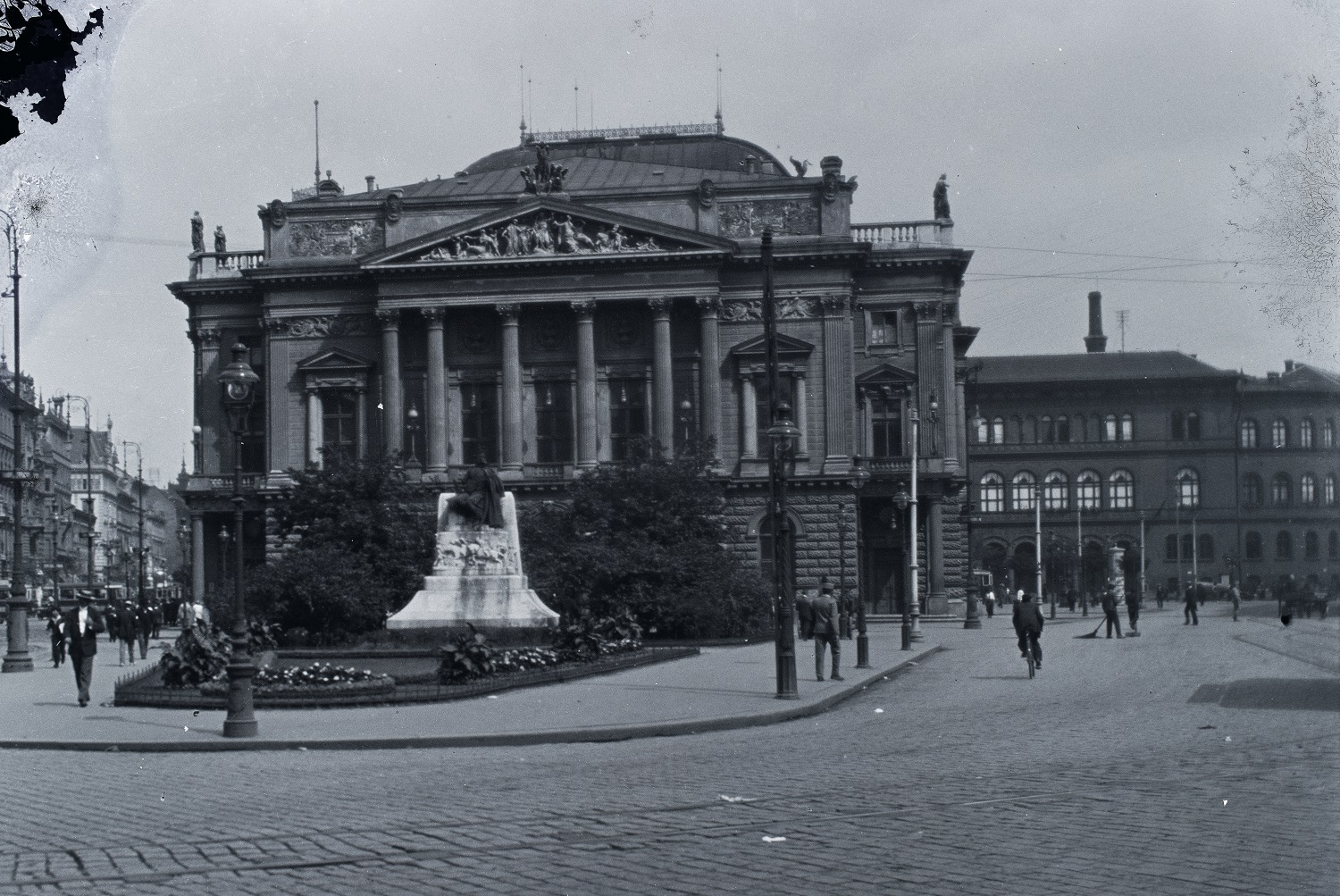 The building housed the National Theatre from 1908 to 1964. The photograph from 1917 shows a statue of Sebestyén Tinódi Lantos by Gyula Bezerédi (Photo: Fortepan/No.: 175054)
The building housed the National Theatre from 1908 to 1964. The photograph from 1917 shows a statue of Sebestyén Tinódi Lantos by Gyula Bezerédi (Photo: Fortepan/No.: 175054)
Severely damaged in the Second World War the building was first repaired. However, the structural damage, metro construction and fire safety issues meant that a massive modernisation would have been needed at the beginning of the 1960s. Eventually, despite public protest, the building was demolished.
The building did not survive to its ninetieth anniversary. The theatre that had been the temple of folk plays, the home of the national theatre, where Lujza Blaha had performed for 21 years (1875–1896) was destroyed through a series of detonations between 15 January and 23 April 1965. A chaotic square now sprawls where it once stood.
Cover photo: The Popular Theatre in 1889 (Photo FSZEK Budapest Collection)

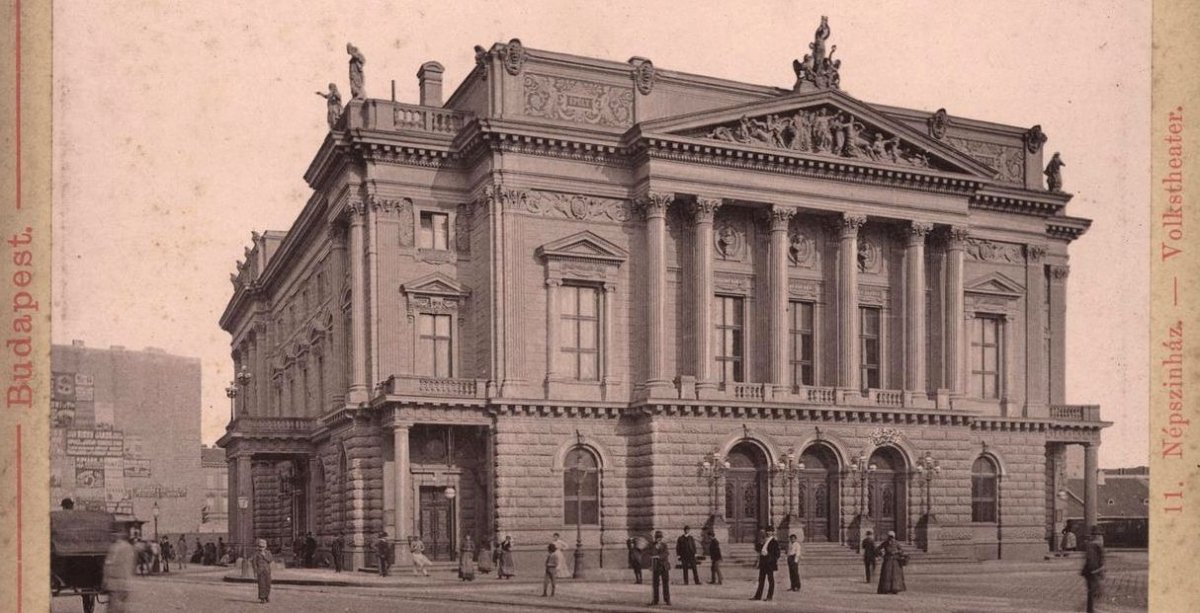



































Hozzászólások
Log in or register to comment!
Login Registration